Survey of Math Chapter 13: Cutting Cake
Cake division between n people has two important ideas:
The cake division procedure is called proportional if each players strategy guarantees the player a piece of value at least 1/n in their estimation;
The cake division procedure is called envy-free if each player at the end has a piece they believe is at least tied for largest.
Consider the following figure, which you want to divide into fair shares between two or three people. What follows are some different ways of dividing it up.
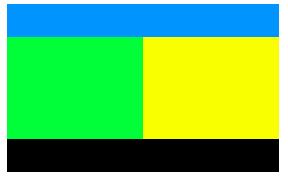
Example Consider dividing between two people, Marge and Zach, where one person cuts the cake.
You can randomly decide who gets to cut the cake through flipping a coin. Say Marge gets to cut the cake, and she likes green and blue, but does not like black and yellow. She weighs her likes and dislikes before deciding how to cut the cake, and makes the following cut:
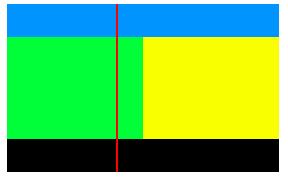
Marge has cut the cake in a way that she would be equally content with either piece, since both sides have some things she likes.
Zach now gets to choose which piece he would like. Since Zach is choosing, he will choose the piece that is most valuable to him, so he will end up with a piece he will not wish to trade with Marge, and a piece which is of value at least one half to him (if it wasn't, he would have chosen the other piece!). Since Marge did the cutting, she would be equally happy no matter which piece she gets. This method, known as divide-and-choose is envy free and proportional.
Example Consider dividing between two people, Marge and Zach, where both people cut the cake.
Continuing from the previous example, we know how Marge would cut the cake.

Now we add a cut based on how Zach feels about an fair division.
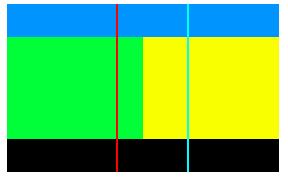
The region to the left of Marge's cut is what she feels is her fair share of the cake. She can take that and be happy
The region to the right of Zach's cut is what he feels is his fair share of the cake. He can take that and be happy
At this point, both Marge and Zach feel they have gotten their fair share of the cake (at least 1/2 of the value). This method is also envy-free and proportional.
The middle piece can be divided proportionally between them, given away, or fed to the dog.
This is called the method of markers, which is not described in your text.
For any two person cake division procedure, if the procedure is proportional it will also be envy-free and vice-versa.
Example Consider dividing between three people, Alfie, Ed, and Denise, where only one of them gets to cut the cake.
Since there are three people now, the cake needs to be cut into three pieces, which will require two cuts.
Randomly decide who will cut the cake. Say Alfie will cut the cake. He cuts the cake in such a way that he would be equally happy with any of the three pieces. This means each piece has value 1/3 to Alfie.
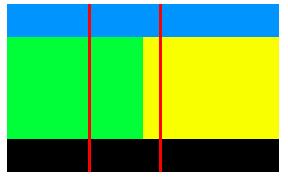
Now we let Ed and Denise look at the three pieces. Ed must think at least one piece has value of 1/3 (if he didn't, he would think the enire cake had value less than 1!), but he might think 2 pieces have value greater than 1/3, or all three pieces have value of exactly 1/3. The same is true for Denise.
Since our goal is to give every player a piece with value to them of at least 1/3, The only problem is if Ed and Denise both think the same piece has value of at least 1/3, and this is the only piece with value greater than 1/3 (you should convince yourself the other scenarios result in everyone getting a piece which to them has value of at least 1/3).
For example, let's say Ed and Denise both think the middle piece has value greater than 1/3, but the end pieces have value less than 1/3. We proceed as follows.
Let Alfie choose one of the pieces not acceptable to Ed and Denise (remember, Alfie cut the cake so the value to him was 1/3 for all pieces). Alfie takes the left most piece and leaves the game.
The remaining cake is reassembled:
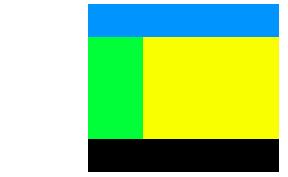
The division begins over again, this time with only Ed and Denise playing. Since there are two players, they can use the divide and choose method described above.
It is randomly decided that Denise shall cut the cake. She makes the following cut:
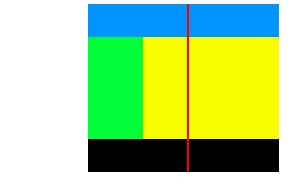
Ed gets to choose which piece he wants. He will get a piece of at least value 1/3 to him (if he didn't, he should choose the other piece!). Since Denise did the cutting, she will get a piece of value at least 1/3 to her (it might be more, since she might feel Alfie got a piece of value less than 1/3 for himself).
Each player using this scheme feels they got at least 1/3 of the value of the cake, so it is proportional. This is called the lone-divider method.
This method is not necessarily envy free. Consider Alfie's perspective when the process is complete. Since Ed and Denise did not approve of the division Alfie created when he made his cuts, neither of them will make the same cut Alfie made when they use the divide and choose method on the remaining cake. Therefore, one of them will end up, in Alfie's mind, with a piece of cake that has value more than 1/3!
Example Consider dividing between three people, Alfie, Ed, and Denise, where everyone gets to cut the cake.
Since there are three people now, the cake needs to be cut into three pieces, which will require two cuts for each person. Here are the cuts that are made.
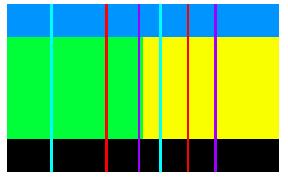
The person who made the blue cuts would be happy with the left end piece, since they identified that as 1/3 value. The person who made the purple cut would be happy with the right end piece, since they identified that as 1/3 value. The person who made the red cuts get the piece between their two cuts. Here is how the cake is divided.

At this point, everyone feels they have received 1/3 of the value (to them) of the cake. The remaining bits can be split again between the three players, or given to the dog to eat.
Every player leaves this game feeling they have received at least 1/3 of the value of the cake, so this is a proportional procedure.